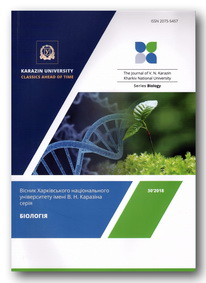Morphological features of primary cultures of adrenal cells of neonatal animals of different species
Abstract
The adrenal gland is an endocrine gland, which in the process of organogenesis is formed from ecto- and mesoderm derivatives. The mechanisms that make cell types of different origins unite, migration routes, and cell interactions are still not fully understood. One of the tools for studying these mechanisms is the primary cell culture obtained from the adrenal gland. The aim of our work was to compare the morphological features of primary cell cultures of model animals belonging to different orders – pigs, rabbits and mice in vitro under various cultivation conditions (growth surface pattern, presence of growth factors), as well as developing methodological approaches for obtaining and maintaining primary cultures of adrenal cell of neonatal animals. Cultivation was performed under standard conditions of temperature and humidity, carbon dioxide concentration, on culture surfaces with normal and reduced adhesiveness in a nutrient medium DMEM enriched with 10% fetal calf serum (FTS) or growth supplements B-27 and FGF. It was established that cell cultures of adrenal neonatal rabbits and piglets that were cultured under conditions of normal adhesion and using FCS had a heterogeneous composition, and were presented as a monolayer consisting of cells of several morphological types, and multicellular spheroids (MS). When cultivated on the surface with reduced adhesive properties in cultures of adrenal glands of piglets and rabbits, a cell monolayer was not formed, but flotation MCs were formed. After transferring MCs of both species to the adhesive culture surface on day 14, cell eviction, their migration from the MCs and formation of a monolayer are observed. Similar stages in the development of primary cell cultures derived from rabbits and piglets suggest the existence of a universal cellular composition in the neonatal adrenal glands of these species and allow applying the same approaches to the primary cultures derived from them. Unlike other studied species, monolayer and MS formation does not occur in cell cultures of mouse neonatal adrenal glands. Cultures consist of single attached and floating cells and small cell aggregates.
Downloads
References
Плаксина Е.М., Сидоренко О.С., Божок Г.А. Морфологические и фенотипические особенности цитосфер, формирующихся в культуре клеток надпочечников неонатальных поросят, в обычных и низкоадгезивных условиях // Проблемы криобиологии и криомедицины. – 2015. – Т.25, №2. – С. 190–196. /Plaksina Ye.M., Sidorenko O.S., Bozhok G.A. Morphological and phenotypic characteristics of cytospheres forming in adrenal gland cell culture of neonatal piglets under normal and low adhesion conditions // Problems of Cryobiology and Cryomedicine. – 2015. – Vol.25, no. 2. – P. 190–196./
Плаксина Е.М., Сидоренко О.С., Легач Е.И., Божок Г.А. Получение культуры нейробластоподобных клеток из надпочечников новорожденных поросят методом селективной адгезии // Проблемы криобиологии и криомедицины. – 2016. – Т.26, №2. – С. 188–195. /Plaksina E.M., Sidorenko O.S., Legach E.I., Bozhok G.A. Obtaining a culture of neuroblast-like cells from adrenal glands of newborn piglets by the method of selective adhesion // Problems of Cryobiology and Cryomedicine. – 2016. – Vol.26, no. 2. – P. 188–195./
Сидоренко О.С., Божок Г.А., Легач Е.И. Экспрессия β-III тубулина в культуре клеток надпочечников новорожденных поросят // Проблемы криобиологии. – 2011. – Т.21, №2. – С. 218–223. /Sidorenko O.S., Bozhok G.A., Legach E.I. β-III tubulin expression in adrenal gland cell culture of newborn piglets // Problems of Cryobiology. – 2011. – Vol.21, no. 2. – P. 218–223./
Bhatt S., Diaz R., Trainor P.A. Signals and switches in mammalian neural crest cell differentiation // Cold Spring Harb Perspect Biology. – 2013. – No. 5 – P. 519–523.
Chung K.F., Sicard F., Vukicevic V. et al. Isolation of neural crest derived chromaffin progenitors from adult adrenal medulla // Stem Cells. – 2009. – Vol.27, no. 10. – P. 2602–2613.
Duval K., Grover H., Han L.H. et al. Modeling physiological events in 2D vs. 3D cell culture // Physiology (Bethesda). – 2017. – Vol.32 (4). – P. 266–277.
Kodaira K., Imada M., Goto M. et al. Purification and identification of a BMP-like factor from bovine serum // Biochemical and Biophysical Research Communications. – 2006. – Vol.345 (3). – P. 1224–1231.
Santana M., Chung K., Vukicevic V. et al. Isolation, characterization and differentiation of progenitor cells from human adult adrenal medulla // Stem Cells Transl. Med. – 2012. – Vol.1 (11). – P. 783–791.
Saxena S., Wahl J., Huber-Lang M.S. et al. Generation of murine sympathoadrenergic progenitor-like cells from embryonic stem cells and postnatal adrenal glands // PLoS ONE. – 2013. – Vol.8 (5). – e64454.
Theveneau E., Mayor R. Neural crest delamination and migration: from epithelium-to-mesenchyme transition to collective cell migration // Developmental Biology. – 2012. – No. 12. – P. 34–54.
Vazquel M.-D., Bouchet P., Mallet J.-L. et al. 3D Reconstruction of the mouse’s mesonephros // Anat. Histol. Embryol. – 1998. – No. 27. – Р. 283–287.
Vukicevic V., Rubin de Celis M.F., Pellegata N.S. et al. Adrenomedullary progenitor cells: isolation and characterization of a multi-potent progenitor cell population // Molecular and Cellular Endocrinology. – 2015. – Vol.408. – Р.178–184.
Authors retain copyright of their work and grant the journal the right of its first publication under the terms of the Creative Commons Attribution License 4.0 International (CC BY 4.0), that allows others to share the work with an acknowledgement of the work's authorship.




